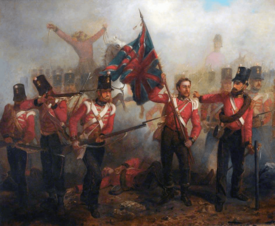Luke O'Connor facts for kids
Quick facts for kids
Luke O'Connor
|
|
|---|---|

Sergeant Luke O'Connor Winning the Victoria Cross at the Battle of Alma (1854). Oil by Louis William Desanges.
|
|
| Born | 20 January 1831 Hillstreet Aughrim, County Roscommon, Ireland |
| Died | 1 February 1915 (aged 84) Clarges Street, London, England |
| Buried |
St Mary's Catholic Cemetery, Kensal Green, London
|
| Allegiance | United Kingdom |
| Service/ |
British Army |
| Years of service | 1849–1887 |
| Rank | Major general |
| Unit | 23rd Regiment of Foot |
| Battles/wars | Crimean War Indian Mutiny Third Anglo-Ashanti War |
| Awards | Victoria Cross Knight Commander of the Order of the Bath Order of the Medjidie (Ottoman Empire) Medal of Military Valor (Sardinia) |
Sir Luke O'Connor (born January 20, 1831 – died February 1, 1915) was a brave Irish soldier. He served in the British Army and became a Major-General. He is famous for being the very first soldier to receive the Victoria Cross. This is Britain's highest award for incredible bravery in battle.
Contents
Luke's Early Life
Luke O'Connor was born in a place called Kilcroy, in County Roscommon, Ireland. His parents were James and Mary O'Connor. When Luke was young, his family had to leave their farm. They decided to move to North America in 1839 to find a better life.
Sadly, Luke's father died during the journey across the sea. His mother and baby brother also passed away from illness when they arrived in Canada. Luke later returned to Ireland as a boy. Some of his other brothers and sisters stayed in North America. They even fought in the American Civil War.
Joining the Army
Luke O'Connor joined the British Army when he was a young man. By the age of 23, he was a sergeant in the 23rd Regiment of Foot. This regiment later became known as The Royal Welch Fusiliers.
Bravery in the Crimean War
Luke's regiment was sent to fight in the Crimean War. On September 20, 1854, a big battle happened at a place called Alma. Sergeant O'Connor was carrying the regimental flag, called the Colour. He was walking between two officers.
One of the officers was badly hurt. At the same time, Sergeant O'Connor was also shot. But he quickly got back up. He grabbed the Colour from the ground and kept carrying it. Even though he was wounded, he stayed in the fight until it was over. People told him to go to the back for his injuries, but he refused.
Luke showed great courage again on September 8, 1855. This was during an attack on a place called the Redan. He was shot through both of his legs during this fierce battle.
The First Victoria Cross
The Victoria Cross medal did not exist when Luke O'Connor fought in the Crimean War. But in 1856, the medal was created. Luke was one of the first 62 soldiers to receive it. They were given their medals in a special ceremony in Hyde Park.
Luke O'Connor was the very first soldier from the Army to get the Victoria Cross. Before him, only sailors from the Royal Navy had received it.
Luke continued his military career. He eventually reached the high rank of Major-General. In 1914, he was made Colonel of his old regiment. You can see his Victoria Cross medal today. It is displayed at the Royal Welch Fusiliers Museum in Caernarfon Castle, Wales.
Later Life and Passing
Major-General Sir Luke O'Connor passed away in London on February 1, 1915. He was buried at St Mary's Catholic Cemetery, Kensal Green, London.
See also

